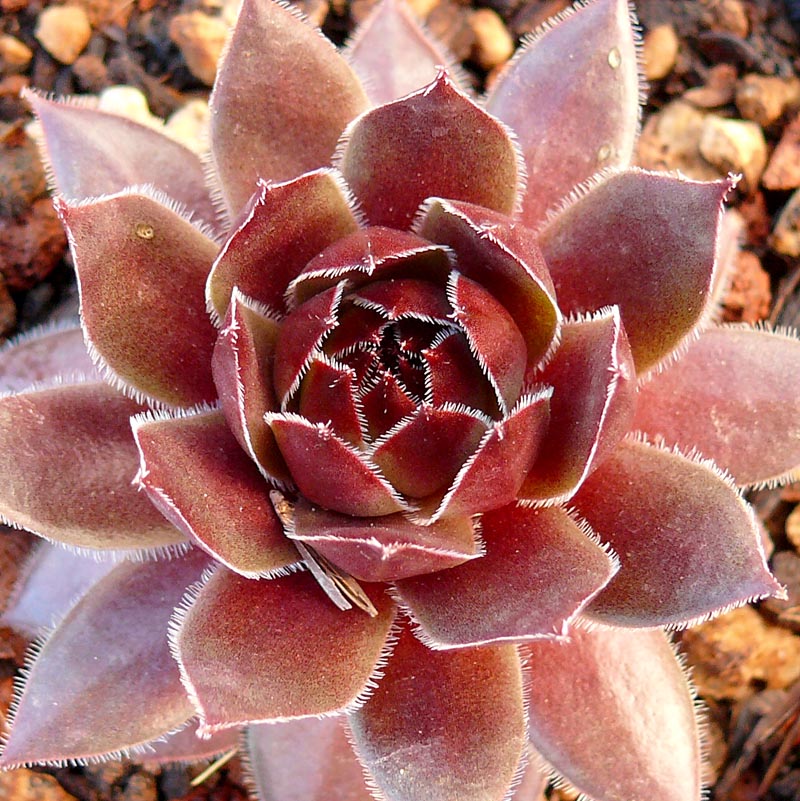This hardy succulent has green rosettes, which become red at the tips during the winter or when exposed to full sunlight. It is monocarpic, meaning it will die after it blooms.
Look out for the arrival of pink blossoms in the summertime, even though it may take multiple years before they appear.
Table of Contents
Care and Propagation Information
Sempervivum ‘Saturn’ adds a unique touch to a hardy garden that can handle cold climates. Not only will it stay vibrant even through snowy winters, but it can also be used as a decorative feature on green roofs. Its ability to spread out and provide ground cover makes it a great choice for anyone hoping to keep deer away. It is sure to supply a splash of color to your winter garden.
Watering
Sempervivum ‘Saturn’ requires the typical amount of water for a succulent. The best way of watering is to follow the “soak and dry” method, which involves allowing the soil to completely dry out before watering again.
Where to Plant
Saturn is capable of surviving in temperatures as low as -20°F (-28.9°C), and can grow in either full or partial sunlight.
How to Propagate Sempervivum ‘Saturn’
Sempervivum ‘Saturn’ can be easily propagated from its offsets. The mother plant will produce a significant number of little ones, which can then be detached and placed in pots or incorporated into displays.
Offsets
Cut the small rosettes off the stem of a Saturn plant with a clean, sharp blade or a pair of scissors. Let the rosettes sit for 1 to 2 days prior to placing them in soil that can readily drain away excess moisture.
Practical uses
Care and Propagation Information
General Care for Sempervivum ‘Saturn’
Sempervivum ‘Saturn’ adds a unique touch to a hardy garden that can handle cold climates. Not only will it stay vibrant even through snowy winters, but it can also be used as a decorative feature on green roofs. Its ability to spread out and provide ground cover makes it a great choice for anyone hoping to keep deer away. It is sure to supply a splash of color to your winter garden.
Watering
Sempervivum ‘Saturn’ requires the typical amount of water for a succulent. The best way of watering is to follow the “soak and dry” method, which involves allowing the soil to completely dry out before watering again.
Where to Plant
Saturn is capable of surviving in temperatures as low as -20°F (-28.9°C), and can grow in either full or partial sunlight.
How to Propagate Sempervivum ‘Saturn’
Sempervivum ‘Saturn’ can be easily propagated from its offsets. The mother plant will produce a significant number of little ones, which can then be detached and placed in pots or incorporated into displays.
Offsets
Cut the small rosettes off the stem of a Saturn plant with a clean, sharp blade or a pair of scissors. Let the rosettes sit for 1 to 2 days prior to placing them in soil that can readily drain away excess moisture.
Practical uses
Sempervivum ‘Saturn’ is an excellent choice for a living roof.
FAQ
Is Sempervivum invasive?
This species is commonly referred to as “houseleek” or “hens and chicks” due to its rosette-forming habit, where the mother plant is surrounded by numerous small offsets.
How do Sempervivum spread?
Allow your mother hen Sempervivum to produce its own young, which will then spread throughout your garden. Once separated from the parent, these chicks will usually take root in the crevices and gaps between stones, but they will also grow in any available space in the garden.
Can Sempervivum be grown outdoors?
Sempervivums are very adaptable plants that can be grown in a variety of ways. They prefer to be outdoors and benefit from sunny locations, but will tolerate some shade. They can be planted in pots, bowls, troughs, or directly into the ground in a rock garden. To get the best results, they should be exposed to as much direct sunlight as possible, but at least a few hours of sunlight a day.
How do you propagate sempervivum?
These plants can be easily propagated by hand because they produce “chicks” (offsets) on stolons (horizontal stems). To propagate, simply remove an offset from the mother plant and place it in soil with partial sun. Make sure to water regularly until it is established with mature roots.
Is Sempervivum annual or perennial?
A plant that lives for more than two years and does not die back in the winter.



